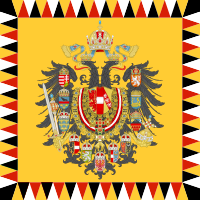Austrian Empire
The Austrian Empire,[a] officially known as the Empire of Austria, was a multinational European great power from 1804 to 1867, created by proclamation out of the realms of the Habsburgs. During its existence, it was the third most populous monarchy in Europe after the Russian Empire and the United Kingdom. Along with Prussia, it was one of the two major powers of the German Confederation. Geographically, it was the third-largest empire in Europe after the Russian Empire and the First French Empire.
This article is about the Habsburg realm between 1804 and 1867. For the Habsburg realms more generally, see Habsburg monarchy. For the Habsburg realm between 1867 and 1918, see Austria-Hungary.
Empire of AustriaKaisertum Österreich (German)
- State1 of the Holy Roman Empire (1804–1806)
- State1 of the German Confederation (1815–1866)
Majority:
Roman Catholic (official)
Minorities:
Lutheranism, Calvinist, Eastern Orthodox, Eastern Catholic, Jewish
- Absolute monarchy (1804–1860)
- Constitutional monarchy[1] (1860–1867)
Klemens von Metternich (first)
11 August 1804
6 August 1806
8 June 1815
13 March 1848
20 October 1860
14 June 1866
30 March 1867
698,700 km2 (269,800 sq mi)
- Gulden
- Thaler (1804–1857)
- Vereinsthaler (1857–1867)
The empire was proclaimed by Francis II in 1804 in response to Napoleon's declaration of the First French Empire, unifying all Habsburg possessions under one central government. It remained part of the Holy Roman Empire until the latter's dissolution in 1806. It continued fighting against Napoleon throughout the Napoleonic Wars, except for a period between 1809 and 1813, when Austria was first allied with Napoleon during the invasion of Russia and later neutral during the first few weeks of the Sixth Coalition War. Austria emerged victorious in the war, and became a leading member of the German Confederation along with Prussia after the Congress of Vienna.
The Kingdom of Hungary—as Regnum Independens—was administered by its own institutions separately from the rest of the empire. After Austria was defeated in the Austro-Prussian War of 1866, the Austro-Hungarian Compromise of 1867 was adopted, joining the Kingdom of Hungary and the Empire of Austria to form Austria-Hungary.
Crown lands of the Austrian Empire after the 1815 Congress of Vienna, including the local government reorganizations from the Revolutions of 1848 to the 1860 October Diploma:
The old Habsburg possessions of Further Austria (in today's France, Germany and Switzerland) had already been lost in the 1805 Peace of Pressburg.
From 1850, Croatia, Slavonia, and the Military Frontier constitute a single land with disaggregated provincial and military administration, and representation.[19]
Administratively, most of the crown lands excluding Hungary, Croatia, Slavonia, Transylvania, Lombardy–Venetia and the Military Frontier were divided into Kreise ('circles'), an administrative division introduced under Maria Theresa in the 18th century. Following the revolutions of 1848 a brief attempt was made to introduce modern-style political districts (in addition to the Kreise),[20] but the reforms of Bach in 1853/54[21] instead instituted a system which delegated the responsibilities of the Kreise among subordinate Amtsbezirke ('office districts'), a system which persisted until 1867.
In the course of the post-1848 reforms Transylvania was also divided into Kreise in 1851[22] (re-divided in 1854[23]); the Voivodeship of Serbia and Banat of Temeschwar was also divided into Kreise.[24]










